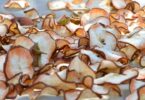Apricots are a type of fruit rich in nutrients that are essential to the human body. With the fiber, vitamin A, potassium, vitamin C, and many other nutrients contained in apricots, the fruit has been proven to be able to reduce the risk of stomach cancer by 47 percent. However, the fruit cannot last for more than a few weeks in the refrigerator unless they are dehydrated. Dehydrating apricots gives them the ability to last a maximum of two years in the fridge.
Here are some methods you can use to dehydrate apricots in your home.
How to Dehydrate Apricots at Home
Sun drying apricots
Dehydration by sun drying is one of the traditional methods used in food preservation. Drying apricots in the sun require temperatures above 98°F (23°C) for it to be efficient. Low humidity is also a necessity so as to prevent spoilage during the process.
- First, you pick your apricots with care and then wash them to remove dirt and pesticides from their skin. You then pit the fruits before cutting them into equal-sized halves or quarters. It is advisable to observe uniformity because then the sliced pieces will dry at a relatively equal rate.
- The second step involves blanching the apricots. Now, uniformly lay out the apricots on cookie sheets. You can also put a Silpat mat over your cookie sheets. It should be noted that using Silpat mats is more recommended as they are easier to clean.
- Cover the apricots with a cheesecloth and air them out in the sun. Covering prevents bugs from tampering with the fruits during the process.
Drying time for the apricots is estimated at a stretch between two and four days, characterised by a daily turning of the fruits to ensure equal drying. Always remember to bring them indoors during the night to avoid dew forming on the fruits.
Dehydrating apricots in the oven
Unlike sun drying where you make use of the sun’s natural heat, this method requires an oven instead.
- Follow the steps in sun drying from picking the apricots to blanching them. This is much applicable to all methods of dehydrating apricots, always taken as preparation.
- You should lay the prepared apricots halves on wire racks. The wire racks are then placed on top of a cookie sheet, making sure that there is no instance where any two pieces are touching one another.
- Set the oven between to 150°F (65°C) before putting the cookie sheet in the oven. Let the fruits cook in the closed oven for about 12 hours, characterized by occasional checking and turning of the pieces.
You can speed up the whole process by adjusting the temperatures to 200°F (95°C), but this will require a closer and keener observation of the fruits lest they over dry, or worse—burn.
SEE ALSO: 5 Easy Steps for Drying Apricots in the Oven
Dehydrating apricots using a microwave
In this method, follow the preparation process outlined above. However, you will have to do an additional step in the preparation process that involves the washing of the microwave’s rotating plate. The plate also has to be dry because you will be placing the apricots directly onto it.
- Lay your pieces on a microwave-safe silicone mat. Put the apricot slices onto the microwave plate, ensuring that there is enough breathing room of at least an inch or two between the pieces.
- Set the timer for 30 minutes and also ensure that the microwave is using the defrost setting instead of the regular microwave setting. Check back after 30 minutes and turn the slices carefully. If they are not yet dry, they can use a few more minutes and then transfer the fruit to a cooling rack in readiness for the string process.
Dehydrating apricots using the microwave takes a shorter period of time as compared to sun drying and oven dehydration. It also saves on resources spent on acquiring a fruit dehydrator or packages of apricots.
However, the method is not reliable, and sometimes, the fruits might still be moist and in need of more drying. If the temperatures are not checked, the fruits might also be burnt.
Using a fruit dehydrator
You will need to have a fruit dehydrator for this method.
- First you should embark on the preparation process outlined in sun drying above, from startup to the pitting of the apricots. However, do not remove the skins but make sure to press the outside center until the flesh spreads out.
- Now, remove the dehydrator racks, spread the apricot pieces onto the racks with the flesh facing up and ensure they are evenly spaced to allow airflow.
- Replace the racks in the dehydrator and set it at 140 °F (60°C). Wait approximately 12 hours, making sure to turn the pieces halfway for even drying. Make sure you also check the manufacturers instructions (time and temperature may vary on different dehydrators).
This method is easy and does not mostly require that you pre-treat the apricots before drying. It is also an easy step by step method that can be carried out without complications. The process, however, is time-consuming and will require keen supervision.
Pro tips!
You can spray some lemon juice on the apricots before placing them on the dehydrator – lemon juice keeps the apricots from browning.
For extra taste – place the apricots on a honey mixture (2:1 water honey ration) for 15 minutes before dehydrating – it adds extra flavour.
How to Store Dehydrated Apricots
Once you are done with dehydrating your apricots, you will need to store them.
READ ALSO: How to Store Dried Apricots
First, allow your apricots to cool before placing them in big glass storage jars to condition the fruits. In conditioning, you will need to shake the jars on a daily basis for a fortnight. In the event of any condensation being noticed, the dry apricots will need to be dried for an hour or so. Place the fruits back in the jars again for another two weeks of conditioning. Once the apricots are completely dry, you can store them in resealable plastic bags that are placed in the pantry or in the refrigerator.





